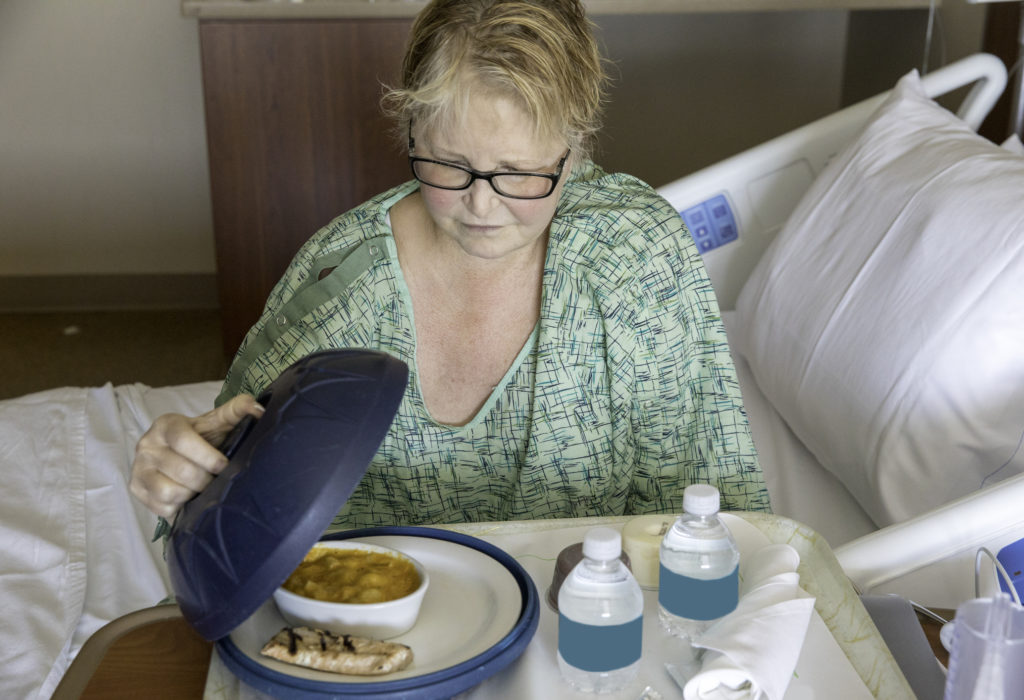
In the past, we have written about contamination control in healthcare facilities and hospitals from a point of view of the environmental hazards that inevitably stem from the congregation of of sickened individuals and their interaction with their healthy caregivers. We’ve looked at ways in which developing technologies can be leveraged to maintain a clean and safe environment in which to heal – technologies, for example, such as the germ-killing UV robots, Zappy and Violet which destroy pathogens by ‘bathing the entire room in a purple glow.’(1) Or the use of Internet of Things (IoT) enabled smart dispensers for antibacterial sanitizer that ensure hand washing compliance by medical professions. But we have not yet looked at the threat posed by the contamination of the food provided to patients within a hospital setting and, given recent events in the UK, it may be time to address that issue…
According to an article in the Journal of the Royal Society of Medicine, two ‘serious’ failures in the public health system this year have led to sickness and deaths in patients both within hospitals and in care homes across the country. The greater proportion of the casualties were affected by streptococcus but of those who died, the culprit was food-borne contamination from listeria. Contracted via the consumption of improperly processed deli meats, unpasteurized milk, or poor server hygiene, listeriosis, as it is also known, is responsible for around 260 deaths in the US annually and manifests as a cluster of symptoms such as muscle aches, fever, GI distress, headaches, confusion, and convulsions. In susceptible individuals, it can lead to septicemia or meningitis or, if it spreads into the brain itself, may also cause cerebral abscesses, meningoencephalitis, or cranial nerve palsies. That’s the worst case scenario, of course, and affects a relatively small number of individuals. Seniors, diabetics, those who are pregnant or in renal failure, patients undergoing chemotherapy or who are otherwise immunosuppressed, or those who are using anti-rheumatoid arthritis medication are all at significant risk if they are exposed to the bacteria. And if this list is sounding alarm bells, it certainly should be, as it is the exact demographic most likely to find themselves in a hospital.
In the case of the recent British listeria outbreaks, patients in facilities in the north of England were affected – one at the Manchester University NHS (National Health Service) Foundation trust and a further two deaths occurred at the nearby Aintree University Hospital in Liverpool. To date, the location of the other patients who died in the course of the outbreak has not been revealed but an investigation traced the source of the infection to sandwiches and salads either supplied directly to patients or sold through the hospital. The vendor of the contaminated items, The Good Food Chain based in Staffordshire, had long supplied pre-packaged meals to 43 NHS trusts and was quick to issue a voluntary recall of affected products.
But how does the consumption of foods that would otherwise seem to be a healthy option – sandwiches and salads – end up being fatal?
The problem in these cases seems to have been chicken meat supplied by a third party, North Country Cooked Meats. According to an article in Food Safety News, tests of the chicken showed a bacterial load of Listeria monocytogenes, ‘at levels of 190 colony forming units per gram [where the] infective dose was estimated to be 10 to 100 million CFU in healthy people, and only 0.1 to 10 million CFU in individuals at high risk of infection.’(2)
Clearly, allowing contamination at this level is a breach of any set of current Good Manufacturing Practices (cGMPs) and demonstrates a failure of the company’s Hazard Analysis and Critical Control Points (HACCP) protocols – assuming that it had one in place.
A review of its website reveals many affirmations of quality control – ‘Our customers enjoy quality products at the right price. They have peace of mind that all our products are lovingly hand prepared in a safe environment, as you would in your own kitchen’ – but no explicit mention of contamination control procedures.(3) Moreover, it also demonstrates a breakdown in the National Health Service’s own HACCP. In-house catering facilities are subject to inspection by the Food Standards Agency (FSA) and have, according to an article published in CheckIt, been underperforming when it comes to food safety: ‘over the past year multiple hospital catering operations (some run by outside contractors) have received extremely low food ratings, with inspectors finding out of date food, a lack of hand washing by staff or mixing of different food types. Others have been marked down because their records were not sufficiently up to date or filled in correctly.’(4)
With these failings in mind, the British government announced this month that it is looking into creating a system of greater oversight for hospital food.
Analysis will include monitoring food safety more closely, offering healthier options that prioritize the nutritional needs of an already vulnerable consumer group, and working in partnership with agencies such as the National Caterers Association to source local foods. Given that the NHS serves more than 140 million meals annually, its reliance on packaged or frozen foods is seen to be an area for improvement. As Health and Social Care Secretary Matt Hancock said in Building Better Healthcare, ‘When people are in hospital, they should be given all the help they can to get better – and that includes food. So I’m determined patients enjoy the best, most-delicious and nutritious food to help them recover and leave hospital as quickly as possible. […] I have seen first-hand how using fresh, locally-sourced ingredients and cooking from scratch have improved the quality of their meals and I want to help more hospitals follow suit by sharing what works best across the country.’(5)
And this final point is of especial interest to us in terms of contamination control. Sourcing local fresh ingredients not only increases diversity of meal options but also the number of individual suppliers to be monitored. So for an agency such as the NHS that already seems to struggle with its duties around food safety, how can we be sure that the integrity of supply chains is preserved?
Fortunately, a potential solution may be found in a surprising technology…How much do you know about Blockchain?

A buzzword more commonly associated with financial systems such as the cryptocurrency Bitcoin, blockchains function, in essence, as a peer-to-peer distributed network with no centralized control. You could think of it like a read-only spreadsheet that is referenced by many parties, all of whom hold complete copies of the data. But where spreadsheets use a row and column format, blockchains use blocks – discrete packages of data that are chained together in chronological order. The first block of a chain is termed the Genesis Block and, of course, the chains that form the ledger can be infinitely long. One of the benefits of using blockchain is that the data is tamper-proof – given that many parties hold a complete copy of the data, no single (and potentially edited) instance can be said to be the definitive version. Moreover, blockchain uses cryptography to further enhance data security as well as leveraging time-sequential ordering that makes the subsequent editing of any given block impossible.
Interestingly, outside of financial transactions, the digitization of supply chains is the next biggest use of blockchain technology. According to TechCrunch, Walmart, for instance, has been developing a food safety blockchain solution for some of its vegetable suppliers. Working in partnership with IBM, Walmart is using the Food Trust Solution which enables the company to better safeguard its products. How? In ‘placing a supply chain on the blockchain, it makes the process more traceable, transparent and fully digital. Each node on the blockchain could represent an entity that has handled the food on the way to the store, making it much easier and faster to see if one of the affected farms sold infected supply to a particular location with much greater precision.’(6)
And this precision is also extremely time-saving. In previous supply chain documentation, it could take up to 7 days to trace the source of a particular food item and if you are a company with the reach of Walmart, seven days represents a lot of time for tainted goods to reach a lot of potential consumers. But using blockchain the 7 days is slashed to just 2.2 seconds. Yes, you did read that correctly: 2.2 seconds.
But isn’t this technology cumbersome and difficult to learn? What are the pain points for suppliers and manufacturers who are set to become blocks along the chain? According to Walmart ‘suppliers don’t have to be blockchain experts by any means. They simply need to know how to upload data to a blockchain application […] Essentially suppliers will [only] need a smart device and internet to participate.’(7)
If that is true, it seems that the demands of adopting a more 21st century approach to securing the supply chain are really not onerous.
And, as Frank Yiannas, Walmart’s VP of Food Safety noted: ‘customers deserve a more transparent supply chain. We felt the one-step-up and one-step-back model of food traceability was outdated […] This is a smart, technology-supported move that will greatly benefit our customers and transform the food system, benefitting all stakeholders.’ In other words, as well as being the right thing to do, it also makes good business sense.
At the time of their product recall this year The Good Food Chain said: ‘Our thoughts and deepest sympathies are with the families of those who have died and anyone else who has been affected by this outbreak. The underlying cause of it remains unclear. […] For our part, we are cooperating fully and transparently with the FSA and other authorities, and will continue to do so.’(8) And the company kept its word, ultimately being cleared of blame by the Food Standards Agency (FSA) for introducing the bacteria into the affected products. The Good Food Chain had the misfortune of being the vector – not the source – of the contamination, and it has certainly paid a heavy price. In June of this year, despite being given the green light to continue trading, the company ceased production completely, citing the devastating impact of the events and subsequent investigation. In an interview with the BBC, owner Martyn Corfield said that the news ‘came too late in the day for us to get the business back on to a sustainable footing’ and as a result the 125 employees, along with 40 temporary staff, lost their jobs as the firm shuttered.(9)
In many ways, it is a sad outcome for a small business with a mission to provide a wholesome product that would revolutionize nutrition in healthcare. But, in a convoluted way, perhaps it has indeed played a role in achieving just that. In the aftermath of these listeria deaths, governmental agencies are being forced to pay closer attention to the quality of food in hospitals and to develop strategies that better track, monitor, and regulate food safety. And while it comes at a hefty price, that has to be a win in terms of future contamination control.
Are you concerned about the quality and safety of food in hospitals? Have you any personal experience of substandard fare? We’d love to hear about your experience!
References:
- https://cleanroom-news.com/2017/02/iot-tech-in-hygiene-compliance/
- https://www.foodsafetynews.com/2019/06/listeria-outbreak-expands-with-two-more-deaths/
- http://www.wholelottagood.co.uk/
- https://www.checkit.net/easing-the-pain-of-hospital-food-safety/
- https://www.buildingbetterhealthcare.co.uk/news/article_page/Hospital_food_review_announced_by_government/158155/cn54406
- https://techcrunch.com/2018/09/24/walmart-is-betting-on-the-blockchain-to-improve-food-safety/
- ibid
- https://www.bbc.com/news/uk-england-stoke-staffordshire-48802869
- ibid
